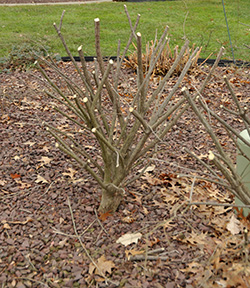Latest Stories

Subscribe to Our Blog
Dormant Prune Now for Beautiful and Healthy Plants All Year

It's winter here in Cleveland, Ohio and unless you have been hibernating down south it's cold out. When you look outside and see snow on the ground and not much red visible on the thermometer I'm sure your first thought probably isn't trudging out to work on the plants in your landscape. It's difficult to get motivated and work outside when the lawn doesn't need mowed and the flowers aren't requiring attention - but the fact is right now is a great time (the only time) to dormant prune your deciduous trees and shrubs.
Due to the advantages of being able to visualize the plants' structure without it's foliage much less effort and guess work is required on your part to prune now in winter than it would at other warmer times of the year. The one exception may be the task putting on all the additional layers of clothing prior to beginning your winter landscaping.
What is Dormant Pruning?
 The practice of dormant pruning is exactly what the name implies. It is the pruning of deciduous trees and shrubs while they are still dormant in the winter. Winter Dormant Pruning is one of the most effective ways to prune your deciduous landscape trees and shrubs and is comprised of three parts:
The practice of dormant pruning is exactly what the name implies. It is the pruning of deciduous trees and shrubs while they are still dormant in the winter. Winter Dormant Pruning is one of the most effective ways to prune your deciduous landscape trees and shrubs and is comprised of three parts:
- Corrective Pruning: This redirects growth to achieve a desired shape and a more natural-looking plant
- Preventative pruning: This removes dead, diseased or damaged plant material as well as problematic branches that may hang over walkways or grow into buildings or homes
- Rejuvenating pruning: Cuts back heavy growth and thins crowded older plants to encourage new growth
When Should We Dormant Prune?
-
Late January through early March when the plant is inactive and fresh wounds are exposed for a shorter period of time
The Many Benefits of Winter Dormant Pruning?
- Maintain a plants size in a limited space
- Revitalize older, woody plants
- Improve the natural branching characteristics of the plant
- A plant pruned during dormancy becomes healthier in the spring as the plant’s energy is directed to its fewer remaining branches which are supported by the same root mass
- In the wintertime, there are no diseases, insects, or leaking plant fluids which can be problematic by infecting, infesting, or otherwise plaguing any pruning cuts
- Without foliage it’s easier to see the area which needs pruned
- When severely reducing the size of a plant, you often are left with a bush that looks like twigs. This is less unsightly in the wintertime





